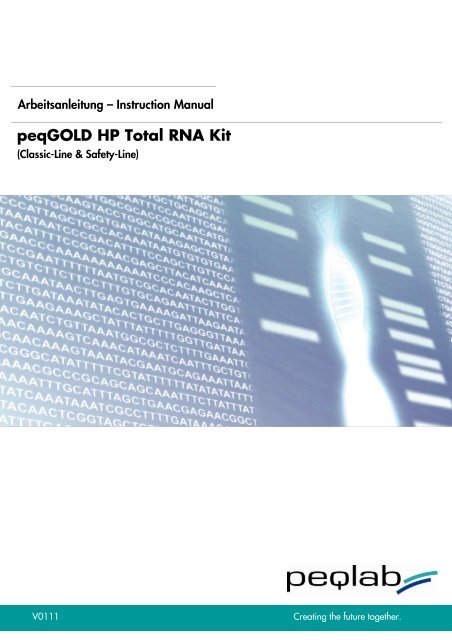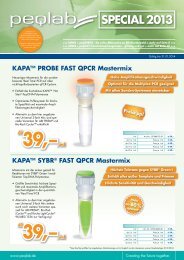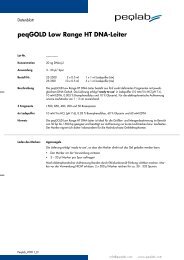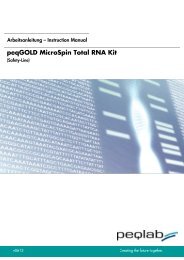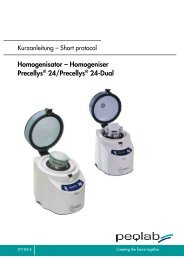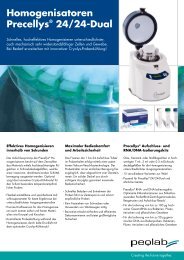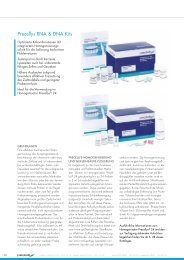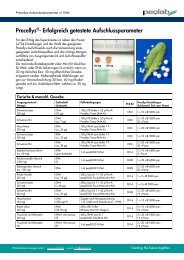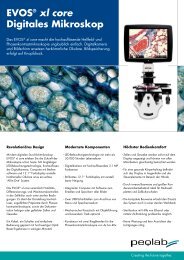peqGOLD HP Total RNA Kit - PEQLAB Biotechnologie GmbH
peqGOLD HP Total RNA Kit - PEQLAB Biotechnologie GmbH
peqGOLD HP Total RNA Kit - PEQLAB Biotechnologie GmbH
Sie wollen auch ein ePaper? Erhöhen Sie die Reichweite Ihrer Titel.
YUMPU macht aus Druck-PDFs automatisch weboptimierte ePaper, die Google liebt.
Arbeitsanleitung – Instruction Manual<br />
<strong>peqGOLD</strong> <strong>HP</strong> <strong>Total</strong> <strong>RNA</strong> <strong>Kit</strong><br />
(Classic-Line & Safety-Line)<br />
V0111 Creating the future together.
INHALT<br />
EINLEITUNG 1<br />
FUNKTIONSPRINZIP 1<br />
KITBESTANDTEILE 2<br />
LAGERUNG 2<br />
WICHTIGE HINWEISE 3<br />
PEQGOLD <strong>HP</strong> TOTAL <strong>RNA</strong> ISOLIERUNGSPROTOKOLLE 4<br />
DNA-KONTAMINATIONEN 7<br />
QUANTIFIZIERUNG UND LAGERUNG DER <strong>RNA</strong> 7<br />
<strong>RNA</strong>-QUALITÄT 8<br />
BESTELLINFORMATIONEN 8<br />
TROUBLESHOOTING TIPS 9<br />
CONTENT<br />
INTRODUCTION 10<br />
THEORY 10<br />
KIT COMPONENTS 11<br />
STORAGE AND STABILITY 11<br />
BEFORE STARTING 12<br />
PEQGOLD <strong>HP</strong> TOTAL <strong>RNA</strong> ISOLATION PROTOCOL 13<br />
DNA CONTAMINATION 16<br />
QUANTITATION AND STORAGE OF <strong>RNA</strong> 16<br />
<strong>RNA</strong> QUALITY 17<br />
ORDERING INFORMATION 17<br />
TROUBLESHOOTING TIPS 17
EINLEITUNG<br />
Der <strong>peqGOLD</strong> <strong>HP</strong> <strong>Total</strong> <strong>RNA</strong> <strong>Kit</strong> kombiniert eine auf Phenol und Guanidinisothiocyanat<br />
basierende Einschritt-Flüssigphasen-Separation mit einer silikatmembran-basierenden<br />
Zentrifugationssäulenmethode, für eine einfache und effiziente Isolierung von Gesamt-<strong>RNA</strong><br />
aus eukaryotischen Zellen und Geweben. Das im <strong>Kit</strong> enthaltene <strong>peqGOLD</strong> TriFast ist ein<br />
gebrauchsfertiges Reagenz optimal geeignet für die Lyse von verschiedenen Geweben,<br />
vor allem für fettreiche Gewebe wie z.B. Gehirn oder Fettgewebe, und inhibiert<br />
gleichzeitig effizient RNasen. Ein optimiertes Puffersystem erlaubt dabei die Aufreinigung<br />
von bis zu 100 µg nicht degradierter Gesamt-<strong>RNA</strong> mit Moleküllängen ab 200 Basen<br />
aufwärts.<br />
<strong>RNA</strong>, die mit den <strong>peqGOLD</strong> <strong>HP</strong> <strong>Total</strong> <strong>RNA</strong> <strong>Kit</strong>s isoliert wurde, kann für alle Arten von<br />
Folgeexperimenten, wie RT-PCRs, Poly(A) + -<strong>RNA</strong>-Extraktionen, Northern Blots, Nuclease<br />
Protection Assays und in vitro-Translationen, weiterverwendet werden.<br />
<strong>peqGOLD</strong> <strong>HP</strong> <strong>Total</strong> <strong>RNA</strong> <strong>Kit</strong>s werden wahlweise mit S- oder mit C-Säulen geliefert (Safety-<br />
Line, Best.-Nr. 12-6935-xx oder Classic-Line, Best.-Nr. 12-6936-xx). Schnappdeckel<br />
sorgen bei den Safety-Line Säulen für einen sicheren Verschluss und zusätzlichen Schutz<br />
vor Kreuzkontaminationen. Classic-Line Säulen haben keinen Deckel und erleichtern so das<br />
Handling.<br />
FUNKTIONSPRINZIP<br />
Aufzuarbeitende Zellen und Gewebe werden zunächst in TriFast Reagenz homogenisiert,<br />
wobei alle vorhandenen RNasen und sonstige Enzyme effizient inhibiert werden. Durch<br />
die Verwendung von TriFast Reagenz ist es möglich auch größere Mengen Gewebe<br />
(bis zu 100 mg Gehirn oder Fettgewebe) auf eine <strong>peqGOLD</strong> PerfectBind <strong>RNA</strong> Column zu<br />
laden und damit die <strong>RNA</strong>-Ausbeute zu erhöhen. Nach der Zugabe von Chloroform und<br />
anschließender Zentrifugation trennt sich das Homogenat in drei Phasen auf. Die <strong>RNA</strong> ist<br />
in der wässrigen Phase enthalten, die DNA in der organischen und der Interphase. Die<br />
Proteine befinden sich in der organischen Phase. Die wässrige Phase wird anschließend<br />
auf eine PerfectBind <strong>RNA</strong> Column geladen, in der die <strong>RNA</strong>-Moleküle an die enthaltene<br />
Silikamembran binden.<br />
Phenol und andere Kontaminationen können durch Waschen mit speziellen Puffern<br />
schnell und einfach entfernt werden. Die gereinigte und qualitativ sehr hochwertige <strong>RNA</strong><br />
wird abschließend in sterilem RNase-free Water eluiert.<br />
<strong>peqGOLD</strong> <strong>HP</strong> <strong>Total</strong> <strong>RNA</strong> Art.-Nr.: 12-6935/12-6936<br />
V.0111 <strong>PEQLAB</strong> <strong>Biotechnologie</strong> <strong>GmbH</strong> 1
KITBESTANDTEILE<br />
<strong>peqGOLD</strong> <strong>HP</strong> <strong>Total</strong> <strong>RNA</strong> <strong>Kit</strong>s 5 Reinigungen 50 Reinigungen 200 Reinigungen<br />
Bestellnummer Classic-Line 12-6936-00 12-6936-01 12-6936-02<br />
Bestellnummer Safety-Line 12-6935-00 12-6935-01 12-6935-02<br />
Bestandteile<br />
PerfectBind <strong>RNA</strong> Columns 5 50 200<br />
2 ml Collection Tubes 15 150 600<br />
TriFast Reagenz 6 ml 55 ml 220 ml<br />
<strong>RNA</strong> Wash Buffer I 5 ml 50 ml 200 ml<br />
<strong>RNA</strong> Wash Buffer II (Konz.) 2 ml 20 ml 3 x 20 ml<br />
RNase-free Water 1 ml 5 ml 20 ml<br />
Arbeitsanleitung 1 1 1<br />
LAGERUNG<br />
Alle Komponenten des <strong>peqGOLD</strong> <strong>HP</strong> <strong>Total</strong> <strong>RNA</strong> <strong>Kit</strong>s, mit Ausnahme des TriFast Reagenz,<br />
sollten bei Raumtemperatur gelagert werden. Die Lagerung des TriFast Reagenz sollte bei<br />
4 °C erfolgen.<br />
Bei Lagerung unter den angegebenen Bedingungen bleiben die Komponenten des <strong>Kit</strong>s für<br />
mindestens 12 Monate ab Lieferung stabil.<br />
<strong>peqGOLD</strong> <strong>HP</strong> <strong>Total</strong> <strong>RNA</strong> Art.-Nr.: 12-6935/12-6936<br />
V.0111 <strong>PEQLAB</strong> <strong>Biotechnologie</strong> <strong>GmbH</strong> 2
WICHTIGE HINWEISE<br />
Bitte lesen Sie das vorliegende Protokoll vor der ersten Verwendung des <strong>Kit</strong>s vollständig<br />
durch und legen Sie vor Präparationsbeginn alle für die Isolierung benötigten Materialien<br />
bereit, um durch unnötige Zeitverzögerungen verursachte <strong>RNA</strong>-Degradationen zu<br />
vermeiden.<br />
! Bei allen Arbeiten mit <strong>RNA</strong> sollten zur Vermeidung von RNase-Kontaminationen<br />
Einmalhandschuhe getragen werden. Zum Pipettieren der im <strong>Kit</strong> enthaltenen Puffer<br />
sollten ausschließlich saubere, RNase-freie Einmalpipettenspitzen verwendet werden.<br />
! <strong>RNA</strong>-Präparationen sollten besonders sorgfältig, daneben aber auch so zügig wie<br />
möglich durchgeführt werden.<br />
! Es ist unbedingt zu empfehlen, dass vor Beginn des Experimentes, die optimale Menge<br />
des Ausgangsmaterials definiert wird.<br />
Die maximale Bindekapazität der <strong>peqGOLD</strong> PerfectBind <strong>RNA</strong> Column beträgt 100 µg.<br />
Bei Proben mit hohem <strong>RNA</strong>-Gehalt empfehlen wir deshalb mit 30 mg Gewebe zu<br />
starten. Bei Proben mit geringem <strong>RNA</strong>-Gehalt empfehlen wir bis zu 100 mg Gewebe<br />
einzusetzen.<br />
! <strong>RNA</strong> Wash Buffer II wird als Konzentrat geliefert und muss vor seiner ersten<br />
Verwendung mit absolutem Ethanol verdünnt werden:<br />
<strong>Kit</strong> 12-6936-00 2 ml <strong>RNA</strong> Wash Buffer II mit 8 ml 100 % EtOH mischen.<br />
<strong>Kit</strong> 12-6936-01 20 ml <strong>RNA</strong> Wash Buffer II mit 80 ml 100 % EtOH mischen.<br />
<strong>Kit</strong> 12-6936-02 3 x 20 ml <strong>RNA</strong> Wash Buffer II mit 3 x 80 ml 100 % EtOH mischen.<br />
! Alle Zentrifugationsschritte müssen bei 22 – 25 °C ausgeführt werden.<br />
<strong>peqGOLD</strong> <strong>HP</strong> <strong>Total</strong> <strong>RNA</strong> Art.-Nr.: 12-6935/12-6936<br />
V.0111 <strong>PEQLAB</strong> <strong>Biotechnologie</strong> <strong>GmbH</strong> 3
PEQGOLD <strong>HP</strong> TOTAL <strong>RNA</strong> ISOLIERUNGSPROTOKOLLE<br />
Eukaryotische Zellen und Gewebe<br />
Benötigte Materialien, die nicht mitgeliefert werden:<br />
! Chloroform<br />
! 100 % Ethanol<br />
! 70 % Ethanol in sterilem DEPC-dH 2O<br />
! Sterile RNase-freie Pipettenspitzen und Zentrifugenröhrchen<br />
1. Homogenisierung und Lyse<br />
a. a. a. Gewebe Gewebe<br />
Gewebe<br />
50 - 100 mg Gewebe werden mit je 1 ml <strong>peqGOLD</strong> TriFast homogenisiert. Um eine<br />
gute Lyse zu erreichen, sollte ein Glas-, ein Teflon- oder ein elektrischer Homogenisator<br />
verwendet werden. Das Probenvolumen sollte nicht mehr als 10 % des verwendeten<br />
<strong>peqGOLD</strong> TriFast-Volumens betragen.<br />
b. b. b. Monolayer Monolayer-Ze<br />
Monolayer Monolayer Ze Zellen Ze llen<br />
Die Zellen werden direkt in der Zellkulturschale durch die Zugabe von 1 ml <strong>peqGOLD</strong><br />
TriFast je 3.5-cm-Schale und durch mehrmaliges Aufziehen mit der Pipette lysiert. Die<br />
Menge an benötigtem <strong>peqGOLD</strong> TriFast ist nicht von der Zellzahl, sondern von der<br />
Größe der Zellkulturschale (in der Regel 1 ml pro 10 cm 2 ) abhängig. Eine unzureichende<br />
Menge an <strong>peqGOLD</strong> TriFast kann zur Kontamination der extrahierten <strong>RNA</strong> mit DNA<br />
führen.<br />
c. Zellsuspensionen<br />
Zellsuspension zentrifugieren und mit 1 ml <strong>peqGOLD</strong> TriFast je 5 - 10 x 10 6 Zellen<br />
resuspendieren. Waschen der Zellen vor der Lyse fördert den Abbau der <strong>RNA</strong> und sollte<br />
vermieden werden.<br />
2. Phasentrennung<br />
Die Proben für 5 Minuten bei Raumtemperatur stehen lassen, um die Dissoziation der<br />
Nukleotidkomplexe zu gewährleisten. Je eingesetztem Milliliter <strong>peqGOLD</strong> TriFast 0.2 ml<br />
Chloroform zugeben und die Proben für 15 Sekunden kräftig schütteln. Danach 3 - 10<br />
Minuten bei Raumtemperatur stehen lassen. Anschließend die Probe für 5 Minuten bei<br />
12.000 x g zentrifugieren um eine Phasenauftrennung zu bekommen. Es bilden sich drei<br />
Phasen: eine untere rote Phenol-Chloroform-Phase, eine obere farblose wässrige Phase<br />
und eine dazwischenliegende Interphase. Die <strong>RNA</strong> ist ausschließlich in der wässrigen<br />
Phase angereichert, während sich die DNA und die Proteine in der Interphase und der<br />
Phenolphase befinden. Die wässrige Phase nimmt dabei ca. 60 % des Probenvolumens<br />
ein.<br />
Das verwendete Chloroform sollte von Zusätzen wie z.B. Isoamylalkohol frei sein.<br />
<strong>peqGOLD</strong> <strong>HP</strong> <strong>Total</strong> <strong>RNA</strong> Art.-Nr.: 12-6935/12-6936<br />
V.0111 <strong>PEQLAB</strong> <strong>Biotechnologie</strong> <strong>GmbH</strong> 4
3. Laden und Binden<br />
Die obere wässrige Phase in ein neues 1.5 ml Tube überführen, mit einem identischen<br />
Volumen 70 % Ethanol versetzen und durch Vortexen sorgfältig mischen. Eine PerfectBind<br />
<strong>RNA</strong> Column in ein 2 ml Collection Tube stecken und 750 µl Probe auf die Säule laden.<br />
PerfectBind <strong>RNA</strong> Column im Tube für 15 Sekunden bei 10.000 x g zentrifugieren.<br />
Säulendurchfluss verwerfen. Schritt wiederholen und restliche wässrige Phase auf die<br />
PerfectBind <strong>RNA</strong> Column laden.<br />
Nach der Zugabe von 70 % Ethanol kann sich ein Präzipitat bilden, das mit der Probe auf die Säule<br />
gegeben werden muss. Das Fassungsvermögen der PerfectBind <strong>RNA</strong> Column beträgt 750 µl. Durch<br />
wiederholtes Befüllen und Zentrifugieren können jedoch auch größere Volumina bearbeitet werden.<br />
Dabei ist jedoch zu beachten, dass die maximale Bindekapazität der PerfectBind <strong>RNA</strong> Column bei<br />
ca. 100 µg <strong>RNA</strong> liegt.<br />
4. Waschen I<br />
500 µl <strong>RNA</strong> Wash Buffer I auf die PerfectBind <strong>RNA</strong> Column pipettieren und für 15<br />
Sekunden bei 10.000 x g durch die Säule zentrifugieren. PerfectBind <strong>RNA</strong> Column auf ein<br />
frisches 2 ml Collection Tube stecken. Säulendurchfluss und altes Collection Tube verwerfen.<br />
5. 5. DNase I Verdau (optional)<br />
Da durch die PerfectBind <strong>RNA</strong>-Technologie die vorhandene DNA größtenteils entfernt<br />
wird, ist ein zusätzlicher DNase-Verdau für die meisten Folgeanwendungen nicht<br />
erforderlich. Dennoch kann es bei einigen sensitiven <strong>RNA</strong>-Anwendungen nötig sein, die<br />
verbliebene DNA durch DNase-Behandlung zu entfernen. Das folgende Protokoll<br />
beschreibt den DNase I-Verdau direkt auf der PerfectBind <strong>RNA</strong> Column.<br />
(Bestellnr.: 12-1091-01/02)<br />
a. Für jede PerfectBind <strong>RNA</strong> Column folgenden DNase I Reaktionsmix vorbereiten:<br />
DNase I Digestion Buffer 73.5 µl<br />
RNase-freie DNase I (20 Kunitz units/µl) 1.5 µl<br />
Gesamtvolumen 75 µl<br />
Hinweis: Hinweis: Hinweis: Hinweis:<br />
1. DNase I ist sehr empfindlich gegenüber physikalischer Denaturierung, deshalb DNase I-<br />
Lösung niemals vortexen! Ein Invertieren des Tubes reicht zum Mischen aus. Den DNase I<br />
Reaktionsmix immer direkt vor der <strong>RNA</strong>-Isolation ansetzen.<br />
2. Der DNase I Digestion Buffer ist im RNase-freien DNase I Digest <strong>Kit</strong> enthalten. Standard<br />
DNase Puffer sind nicht für den "on-membrane" Verdau geeignet!<br />
b. 75 µl des DNase I Reakionsmixes direkt auf die Membran der PerfectBind <strong>RNA</strong> Column<br />
pipettieren. Der DNase I Verdau kann nicht vollständig ablaufen, wenn ein Teil des<br />
Reaktionsmixes an der Wand oder dem O-Ring der Säule haftet.<br />
c. PerfectBind <strong>RNA</strong> Column bei Raumtemperatur (25 - 30 °C) für 15 Minuten inkubieren.<br />
<strong>peqGOLD</strong> <strong>HP</strong> <strong>Total</strong> <strong>RNA</strong> Art.-Nr.: 12-6935/12-6936<br />
V.0111 <strong>PEQLAB</strong> <strong>Biotechnologie</strong> <strong>GmbH</strong> 5
d. d. PerfectBind <strong>RNA</strong> Column in ein neues 2 ml Collection Tube stecken und 400 µl <strong>RNA</strong><br />
Wash Buffer I zugeben. PerfectBind <strong>RNA</strong> Column bei Raumtemperatur für 5 Minuten<br />
inkubieren. Anschließend bei 10.000 x g für 5 Minuten zentrifugieren und Durchfluss<br />
verwerfen. Collection Tube im nächsten Schritt (Schritt 6) weiterverwenden.<br />
6. Waschen II<br />
600 µl des komplettierten <strong>RNA</strong> Wash Buffers II (Pufferkonzentrat plus 4 Volumen 100 %<br />
Ethanol) auf die PerfectBind <strong>RNA</strong> Column pipettieren und für 15 Sekunden bei 10.000 x g<br />
durch die Säule zentrifugieren. Waschschritt wiederholen. Säulendurchfluss verwerfen.<br />
7. 7. Trocknen (Essentieller Schritt! Zeit nicht verkürzen!)<br />
PerfectBind <strong>RNA</strong> Column in das geleerte 2 ml Collection Tube stecken und durch<br />
einminütiges Zentrifugieren bei 10.000 x g vollständig trocknen.<br />
8. 8. Elution<br />
PerfectBind <strong>RNA</strong> Column in ein sauberes 1.5 ml Zentrifugenröhrchen stecken und die <strong>RNA</strong><br />
mit 50 µl bis 100 µl sterilem RNase-free Water eluieren. Dazu direkt auf die Matrix<br />
pipettieren und 1 Minute bei 10.000 x g zentrifugieren.<br />
Bei erwarteten <strong>RNA</strong>-Erträgen > 50 µg kann zur vollständigen Rückgewinnung der <strong>RNA</strong> eine zweite<br />
Elutionsrunde notwendig sein. Dabei ist zu berücksichtigen, dass zwar der absolute Ertrag<br />
verbessert wird, die <strong>RNA</strong>-Konzentration jedoch sinkt, da bereits bei der ersten Elution mehr als<br />
80 % der gereinigten <strong>RNA</strong> zurückgewonnen werden. Ein Vorwärmen des RNase-free Water auf<br />
70 °C und eine der Zentrifugation vorangehende fünfminütige Inkubation der PerfectBind <strong>RNA</strong><br />
Column können die Erträge noch weiter verbessern. Statt einer zweiten Elutionsrunde kann die <strong>RNA</strong><br />
auch direkt in einem größeren Volumen RNase-free Water eluiert werden.<br />
<strong>peqGOLD</strong> <strong>HP</strong> <strong>Total</strong> <strong>RNA</strong> Art.-Nr.: 12-6935/12-6936<br />
V.0111 <strong>PEQLAB</strong> <strong>Biotechnologie</strong> <strong>GmbH</strong> 6
DNA-KONTAMINATIONEN<br />
Mit keinem der aktuell verfügbaren <strong>RNA</strong>-Extraktionssysteme ist es möglich, genomische<br />
DNA vollständig zu entfernen. Für sensitive Experimente wie Differential Display oder RT-<br />
PCRs muss deshalb ein DNase I Verdau durchgeführt werden. Eine einfache und<br />
zeitsparende Möglichkeit bietet der DNase-Verdau direkt auf der Säule, der in das<br />
bestehende Protokoll zwischen den Waschschritten integriert werden kann (s. Punkt 5:<br />
DNase I Verdau). Alternativ kann auch eine Nachbehandlung der isolierten <strong>RNA</strong> mit<br />
RNase-freier DNase durchgeführt werden.<br />
Der Nachweis des Vorhandenseins oder Fehlens von DNA-Kontaminationen kann mit Hilfe<br />
von intronüberspannenden Primern erfolgen, wobei das Entstehen von Banden Rückschlüsse<br />
auf mögliche Kontaminationen zulässt.<br />
QUANTIFIZIERUNG UND LAGERUNG DER <strong>RNA</strong><br />
Um die Konzentration und Reinheit einer <strong>RNA</strong>-Lösung zu bestimmen, muss die Absorption<br />
eines geeignet verdünnten Aliquots (10- bis 50-fach) bei 260 nm und 280 nm gemessen<br />
werden.<br />
RNase-free Water ist leicht sauer und kann die gemessenen Absorptionswerte dramatisch herabsetzen.<br />
Für die spektrophotometrische Analyse sollte die <strong>RNA</strong> deshalb besser in einer gepufferten<br />
Lösung wie beispielsweise TE verdünnt werden.<br />
Eine A 260-Einheit entspricht dabei 40 µg <strong>RNA</strong>/ml. Die Konzentration berechnet sich<br />
demnach wie folgt:<br />
<strong>RNA</strong>-Konzentration (µg/ml) = Absorption 260 x 40 x Verdünnungsfaktor<br />
Das A 260/280-Verhältnis reiner Nukleinsäuren liegt bei 2.0. Das mit dem <strong>peqGOLD</strong> <strong>HP</strong> <strong>Total</strong><br />
<strong>RNA</strong> <strong>Kit</strong> erzielbare A 260/280-Verhältnis von 1.8 bis 2.0 entspricht deshalb <strong>RNA</strong> einer<br />
Reinheit von 90 % bis 100 %.<br />
<strong>RNA</strong>, die mit dem <strong>peqGOLD</strong> <strong>HP</strong> <strong>Total</strong> <strong>RNA</strong> <strong>Kit</strong> aufgereinigt wurde, kann in sterilem RNasefree<br />
Water für mindestens ein Jahr bei – 70 °C aufbewahrt werden.<br />
<strong>peqGOLD</strong> <strong>HP</strong> <strong>Total</strong> <strong>RNA</strong> Art.-Nr.: 12-6935/12-6936<br />
V.0111 <strong>PEQLAB</strong> <strong>Biotechnologie</strong> <strong>GmbH</strong> 7
<strong>RNA</strong>-QUALITÄT<br />
Vor ihrer Verwendung in Folgeexperimenten sollte durch denaturierende Agarosegelelektrophorese<br />
und Ethidiumbromidfärbung zunächst noch die Qualität der extrahierten<br />
<strong>RNA</strong> bestimmt werden. Auf dem gefärbten Gel müssen zwei scharfe Banden erkennbar<br />
sein, die die ribosomalen 28 S und 18 S r<strong>RNA</strong>s repräsentieren. Sollten diese Banden in<br />
Richtung niedermolekularer <strong>RNA</strong>-Größen schmieren, ist es während der Präparation,<br />
Lagerung oder Weiterbearbeitung zu einer Degradation gekommen, die sich je nach<br />
Folgeexperiment mehr oder weniger negativ auswirken kann.<br />
Obwohl <strong>RNA</strong>-Moleküle < 200 Basen nur sehr ineffizient an die PerfectBind-Silikamatrix des<br />
<strong>peqGOLD</strong> <strong>HP</strong> <strong>Total</strong> <strong>RNA</strong> <strong>Kit</strong>s binden, kann auf dem Gel noch eine dritte distinkte Bande aus t<strong>RNA</strong>s<br />
erscheinen. Diese Bande tritt vor allem dann auf, wenn die Zellzahl im Ausgangsmaterial besonders<br />
hoch war.<br />
BESTELLINFORMATIONEN<br />
für die <strong>RNA</strong>-Isolierung aus Zellen, Geweben und Blut:<br />
<strong>peqGOLD</strong> <strong>HP</strong> <strong>Total</strong> <strong>RNA</strong> <strong>Kit</strong><br />
(Classic-Line)<br />
<strong>peqGOLD</strong> <strong>HP</strong> <strong>Total</strong> <strong>RNA</strong> <strong>Kit</strong><br />
(Safety-Line)<br />
<strong>peqGOLD</strong> <strong>Total</strong> <strong>RNA</strong> <strong>Kit</strong><br />
(Classic-Line)<br />
<strong>peqGOLD</strong> <strong>Total</strong> <strong>RNA</strong> <strong>Kit</strong><br />
(Safety-Line)<br />
<strong>peqGOLD</strong> Blood <strong>RNA</strong> <strong>Kit</strong><br />
(Safety-Line)<br />
12-6936-00 5 Reinigungen<br />
12-6936-01 50 Reinigungen<br />
12-6936-02 200 Reinigungen<br />
12-6935-00 5 Reinigungen<br />
12-6935-01 50 Reinigungen<br />
12-6935-02 200 Reinigungen<br />
12-6634-00 5 Reinigungen<br />
12-6634-01 50 Reinigungen<br />
12-6634-02 200 Reinigungen<br />
12-6834-00 5 Reinigungen<br />
12-6834-01 50 Reinigungen<br />
12-6834-02 200 Reinigungen<br />
12-6814-00 5 Reinigungen<br />
12-6814-01 50 Reinigungen<br />
12-6814-02 200 Reinigungen<br />
<strong>peqGOLD</strong> <strong>HP</strong> <strong>Total</strong> <strong>RNA</strong> Art.-Nr.: 12-6935/12-6936<br />
V.0111 <strong>PEQLAB</strong> <strong>Biotechnologie</strong> <strong>GmbH</strong> 8
TROUBLESHOOTING TIPS<br />
Problem Ursache Abhilfe<br />
Wenig oder keine<br />
<strong>RNA</strong> im Eluat<br />
<strong>RNA</strong> bleibt auf der Säule<br />
Elution wiederholen.<br />
RNase-free Water vor dem Eluieren auf 70 °C<br />
erwärmen.<br />
Säule vor dem Eluieren für 10 min mit RNasefree<br />
Water inkubieren.<br />
Säule ist überladen Menge des Ausgangsmaterials reduzieren.<br />
Säule verstopft Unvollständige Homogenisierung<br />
<strong>RNA</strong>-Degradation<br />
DNA-<br />
Kontamination<br />
Niedrige<br />
Absorptionsraten<br />
Probleme bei<br />
Folgereaktionen<br />
Schlechtes Ausgangsmaterial<br />
RNase-Kontamination<br />
Physikalische Ähnlichkeit von<br />
<strong>RNA</strong> und DNA<br />
<strong>RNA</strong> in saurem Puffer oder<br />
Wasser verdünnt<br />
Salzübertragung während<br />
der Elution<br />
Probe vollständig homogenisieren.<br />
Zentrifugationszeit verlängern.<br />
Menge des Ausgangsmaterials reduzieren.<br />
Ausgangsmaterial sofort nach Probennahme in<br />
Stickstoff einfrieren.<br />
Ausgangsmaterial erst lysieren und dann<br />
lagern.<br />
Präparation zügiger und exakter nach<br />
Vorschrift durchführen.<br />
Nur RNase-freies Material verwenden und<br />
Handschuhe tragen.<br />
Puffer auf RNase-Kontaminationen überprüfen.<br />
Verdau mit RNase-freier DNase. (5 min bei<br />
37 °C inkubieren.)<br />
RNase-free Water ist sauer und kann die A 260-<br />
Werte dramatisch herabsetzen. Zum Messen in<br />
TE-Puffer verdünnen.<br />
Sicherstellen, dass <strong>RNA</strong> Wash Buffer II mit 4<br />
Volumen 100 % EtOH verdünnt wurde.<br />
Sicherstellen, dass <strong>RNA</strong> Wash Buffer II bei<br />
Raumtemperatur gelagert und verwendet<br />
wurde.<br />
Waschschritt mit <strong>RNA</strong> Wash Buffer II<br />
wiederholen.<br />
<strong>peqGOLD</strong> <strong>HP</strong> <strong>Total</strong> <strong>RNA</strong> Art.-Nr.: 12-6935/12-6936<br />
V.0111 <strong>PEQLAB</strong> <strong>Biotechnologie</strong> <strong>GmbH</strong> 9
INTRODUCTION<br />
<strong>peqGOLD</strong> <strong>HP</strong> <strong>Total</strong> <strong>RNA</strong> <strong>Kit</strong>s integrate phenol/guanidine-based lysis and silicamembrane<br />
purification of total <strong>RNA</strong>. TriFast Reagent, included in the kits, is a<br />
monophasic solution of phenol and guanidine thiocyanate, designed to facilitate lysis of<br />
different sources of samples especially for fatty tissues such as brain and adipose tissue<br />
and inhibit RNases. With the <strong>peqGOLD</strong> <strong>HP</strong> <strong>Total</strong> <strong>RNA</strong> <strong>Kit</strong>s, all <strong>RNA</strong> molecules longer<br />
than 200 nucleotides are isolated.<br />
<strong>RNA</strong> purified using the <strong>peqGOLD</strong> <strong>HP</strong> <strong>Total</strong> <strong>RNA</strong> <strong>Kit</strong> is ready for applications such as RT-<br />
PCR, Northern blotting, poly(A) + -<strong>RNA</strong> (m<strong>RNA</strong>) purification, nuclease protection assays<br />
and in vitro translation.<br />
<strong>peqGOLD</strong> <strong>HP</strong> <strong>Total</strong> <strong>RNA</strong> <strong>Kit</strong>s are available as S- or C-line columns (Safety-Line, # 12-<br />
6935-xx or Classic Line, # 12-6936-xx). Safety-Line columns can be closed tightly by lids<br />
to avoid cross-contamination more effectively. Classic-Line colums do not have lids for a<br />
more comfortable handling.<br />
THEORY<br />
The high lysis efficiency of the TriFast Reagent enables use of larger amounts of tissue<br />
(up to 100 mg of brain or adipose tissue) with the <strong>peqGOLD</strong> PerfectBind <strong>RNA</strong> Column.<br />
Tissue samples are homogenized in TriFast Reagent. After addition of chloroform, the<br />
homogenate is separated into aqueous and organic phases by centrifugation. <strong>RNA</strong><br />
partitions to the upper, aqueous phase while DNA partitions to the interphase and<br />
proteins to the lower, organic phase or the interphase.<br />
The upper, aqueous phase is extracted, and ethanol is added to provide appropriate<br />
binding conditions. The sample is then applied to the PerfectBind <strong>RNA</strong> Column, where the<br />
total <strong>RNA</strong> binds to the membrane and phenol and other contaminants are efficiently<br />
washed away. High-quality <strong>RNA</strong> is then eluted in RNase-free Water.<br />
<strong>peqGOLD</strong> <strong>HP</strong> <strong>Total</strong> <strong>RNA</strong> <strong>Kit</strong> Ord.-No.: 12-6935/12-6936<br />
V.0111 <strong>PEQLAB</strong> <strong>Biotechnologie</strong> <strong>GmbH</strong> 10
KIT COMPONENTS<br />
<strong>peqGOLD</strong> <strong>HP</strong> <strong>Total</strong> <strong>RNA</strong> <strong>Kit</strong>s 5 Purifications 50 Purifications 200 Purifications<br />
Product Number Classic-Line 12-6936-00 12-6936-01 12-6936-02<br />
Product Number Safety-Line 12-6935-00 12-6935-01 12-6935-02<br />
Bestandteile<br />
PerfectBind <strong>RNA</strong> Columns 5 50 200<br />
2 ml Collection Tubes 15 150 600<br />
TriFast Reagent 6 ml 55 ml 220 ml<br />
<strong>RNA</strong> Wash Buffer I 5 ml 50 ml 200 ml<br />
<strong>RNA</strong> Wash Buffer II (Conc.) 2 ml 20 ml 3 x 20 ml<br />
RNase-free Water 1 ml 5 ml 20 ml<br />
Instruction manual 1 1 1<br />
STORAGE AND STABILITY<br />
All components except TriFast Reagent in <strong>peqGOLD</strong> <strong>HP</strong> <strong>Total</strong> <strong>RNA</strong> <strong>Kit</strong> should be stored<br />
at room temperature. TriFast Reagent should be stored at 4 °C.<br />
All <strong>peqGOLD</strong> <strong>HP</strong> <strong>Total</strong> <strong>RNA</strong> <strong>Kit</strong> components are stable for at least 12 months from the<br />
date of purchase when stored at 22 - 25 °C.<br />
<strong>peqGOLD</strong> <strong>HP</strong> <strong>Total</strong> <strong>RNA</strong> <strong>Kit</strong> Ord.-No.: 12-6935/12-6936<br />
V.0111 <strong>PEQLAB</strong> <strong>Biotechnologie</strong> <strong>GmbH</strong> 11
BEFORE STARTING<br />
Briefly examine this booklet and become familiar with each step. Prepare all components<br />
and have the necessary materials ready before starting.<br />
! Whenever working with <strong>RNA</strong>, always wear one-way gloves to minimize RNase<br />
contamination. Use only fresh RNase-free disposable plastic pipette tips when using<br />
the supplied reagents.<br />
! Work carefully but as quickly as possible during the procedure.<br />
! It It is is very very important important to to determine determine the the correct correct amount amount of of starting starting material material before before the<br />
the<br />
experiment experiment. experiment<br />
The capacity of the PerfectBind <strong>RNA</strong> Column is 100 µg. For samples containing high<br />
amount of <strong>RNA</strong>, we suggest using 30 mg tissue to start. For samples containing lower<br />
level <strong>RNA</strong>, the maximum amount of starting material (100 mg) can be used.<br />
! <strong>RNA</strong> Wash Buffer II is concentrated and has to be diluted with absolute ethanol as<br />
follows:<br />
<strong>Kit</strong> 12-6936-00 Add 8 ml 100 % EtOH to 2 ml <strong>RNA</strong> Wash Buffer II<br />
<strong>Kit</strong> 12-6936-01 Add 80 ml 100 % EtOH to 20 ml <strong>RNA</strong> Wash Buffer II<br />
<strong>Kit</strong> 12-6936-02 Add 3 x 80 ml 100 % EtOH to 3 x 20 ml <strong>RNA</strong> Wash Buffer II<br />
! All steps must be carried out at room temperature (22 – 25 °C).<br />
<strong>peqGOLD</strong> <strong>HP</strong> <strong>Total</strong> <strong>RNA</strong> <strong>Kit</strong> Ord.-No.: 12-6935/12-6936<br />
V.0111 <strong>PEQLAB</strong> <strong>Biotechnologie</strong> <strong>GmbH</strong> 12
PEQGOLD <strong>HP</strong> TOTAL <strong>RNA</strong> ISOLATION PROTOCOL<br />
Eucaryotic cells and tissue<br />
Materials required, but not supplied:<br />
! Chloroform<br />
! 100 % Ethanol<br />
! 70 % Ethanol in sterile DEPC-dH 2O<br />
! Sterile RNase-free pipet tips and centrifuge tubes<br />
1. 1. Homogenization Homogenization Homogenization and and and Lysis Lysis<br />
Lysis<br />
a. a. Tissue<br />
Tissue<br />
Homogenize tissue samples in 1ml TriFast per 50 - 100 mg tissue. For efficient lysis use<br />
a glass-Teflon or power homogenizer. The sample volume should not exceed 10 % of the<br />
volume of TriFast used for the homogenization.<br />
b. b. b. Monolayer Monolayer Monolayer cells cells<br />
cells<br />
Lyse cells directly in a culture dish by addition of 1 ml TriFast to a 3.5 cm diameter dish<br />
and passing the cell lysate several times through a pipette. The amount of TriFast<br />
needed is based on the area of the culture dish (1 ml per 10 cm 2 ) and not on the number<br />
of cells. An insufficient amount of TriFast may result in contamination of the isolated<br />
<strong>RNA</strong> with DNA.<br />
c. c. Suspension Suspension Suspension culture<br />
culture<br />
Pellet cells by centrifugation. Lyse cells in TriFast by pipetting. Add 1 ml reagent per<br />
5 - 10 x 10 6 of cells. Washing cells before the addition of TriFast should be avoided as<br />
this increases the possibility of <strong>RNA</strong> degradation.<br />
2. 2. Phase Phase Separation Separation<br />
Separation<br />
For dissociation of the nucleoprotein complexes the samples should be kept for 5 minutes<br />
at room temperature. Add 0.2 ml of chloroform per 1 ml of <strong>peqGOLD</strong> TriFast and<br />
shake samples by hand vigorously for 15 seconds. Keep them for 3 - 10 minutes at room<br />
temperature. During centrifugation at 12.000 x g for 5 minutes the mixture separates into<br />
the lower red (phenol-chloroform phase), the interphase and the colourless upper<br />
aqueous phase. <strong>RNA</strong> is forced exclusively into the aqueous phase whereas DNA and the<br />
proteins partition into the interphase and lower phenol phase. The volume of the <strong>RNA</strong><br />
containing phase is about 60 % of the volume of the TriFast used for homogenization.<br />
Chloroform used in this experiment should be free of additives like isoamyl alcohol or others.<br />
<strong>peqGOLD</strong> <strong>HP</strong> <strong>Total</strong> <strong>RNA</strong> <strong>Kit</strong> Ord.-No.: 12-6935/12-6936<br />
V.0111 <strong>PEQLAB</strong> <strong>Biotechnologie</strong> <strong>GmbH</strong> 13
3. 3. Load Load and and bind<br />
bind<br />
Transfer the upper aqueous phase into a new 1.5 ml centrifuge tube. Add an equal<br />
volume 70 % Ethanol to the lysate and mix thoroughly by vortexing. Place a PerfectBind<br />
<strong>RNA</strong> Column in a 2 ml Collection Tube and add 750 µl of the lysate directly to the<br />
membrane. Centrifuge the PerfectBind <strong>RNA</strong> Column/Collection Tube assembly at<br />
10.000 x g for 15 sec. Pour off the flow-through liquid. Repeat this step by loading the<br />
remaining lysate to the column.<br />
A precipitate may form on addition of 70 % ethanol. This will not interfere with <strong>RNA</strong> purification.<br />
Vortex and add the entire mixture to the column. The maximum capacity of the spin column is<br />
750 µl, larger volumes can be loaded successively by repeating the loading procedure. However,<br />
the total binding capacity of a spin column is 100 µg <strong>RNA</strong>.<br />
4. 4. 4. Wash Wash Wash II<br />
I I<br />
Add 500 µl <strong>RNA</strong> Wash Buffer I to the PerfectBind <strong>RNA</strong> Column and centrifuge for 15 sec<br />
at 10.000 x g. Place the PerfectBind <strong>RNA</strong> Column in a fresh 2 ml Collection Tube.<br />
Discard the flow-throw liquid and the used Collection Tube.<br />
5. DNase DNase I I Digestion Digestion (optional)<br />
Since PerfectBind <strong>RNA</strong> resin and spin-column technology actually removes most of DNA<br />
without the DNase treatment, it is not necessary to do DNase digestion for most<br />
downstream applications. However, certain sensitive <strong>RNA</strong> applications might require<br />
further DNA removal. Following steps provide on-membrane DNase I digestion (Order<br />
No. 12-1091).<br />
a. For each PerfectBind <strong>RNA</strong> Column, prepare this DNase I digestion reaction mix:<br />
DNase I Digestion Buffer 73.5 µl<br />
RNase-free DNase I (20 Kunitz units/µl) 1.5 µl<br />
<strong>Total</strong> volume 75 µl<br />
Note:<br />
1. DNase I is very sensitive for physical denaturation, so do not vortex this DNase I mixture!<br />
Mix gently by inverting the tube. Prepare the fresh DNase I digestion mixture directly before<br />
<strong>RNA</strong> isolation.<br />
2. DNase I Digestion Buffer is supplied with RNase-free DNase set. Standard DNase buffers<br />
are not compatible with on-membrane DNase digestion!<br />
b. Pipet 75 µl of the DNase I digestion reaction mix directly onto the surface of<br />
PerfectBind <strong>RNA</strong> resin in each column. Make sure to pipet the DNase I digestion<br />
mixture directly onto the membrane. DNase I digestion will not be complete if some of<br />
the mix stick to the wall or the O-ring of the PerfectBind <strong>RNA</strong> Column.<br />
c. Incubate at room temperature (25 - 30 °C) for 15 minutes.<br />
<strong>peqGOLD</strong> <strong>HP</strong> <strong>Total</strong> <strong>RNA</strong> <strong>Kit</strong> Ord.-No.: 12-6935/12-6936<br />
V.0111 <strong>PEQLAB</strong> <strong>Biotechnologie</strong> <strong>GmbH</strong> 14
d. Place the PerfectBind <strong>RNA</strong> Column into a new 2 ml Collection Tube and add 400 µl<br />
<strong>RNA</strong> Wash Buffer I. Place the PerfectBind <strong>RNA</strong> Column at benchtop for 5 minutes.<br />
Centrifuge at 10.000 x g for 5 minutes and discard flow-through. Re-use Collection<br />
Tube in the next step. Continue with step 6.<br />
6. 6. Wash Wash Wash II II<br />
II<br />
Add 600 µl completed <strong>RNA</strong> Wash Buffer II to the PerfectBind <strong>RNA</strong> Column and centrifuge<br />
for 15 sec at 10.000 x g. Repeat this wash step and discard the flow-through liquid.<br />
7. 7. Dry Dry Dry (Important, do not skip this step!)<br />
Place the PerfectBind <strong>RNA</strong> Column containing your <strong>RNA</strong> in the Collection Tube and<br />
centrifuge for 1 min at 10.000 x g to dry the column matrix.<br />
8. Elution<br />
Elution<br />
Place the PerfectBind <strong>RNA</strong> Column into a fresh 1.5 ml microcentrifuge tube. Add<br />
50 – 100 µl sterile RNase-free Water directly to the binding matrix in the PerfectBind<br />
<strong>RNA</strong> Column and centrifuge for 1 min at 10.000 x g to elute <strong>RNA</strong>.<br />
A second elution may be necessary if the expected yield of <strong>RNA</strong> is > 50 µg. Alternatively, <strong>RNA</strong><br />
may be eluted with a higher volume of water. While additional elution increase total <strong>RNA</strong> yield,<br />
the concentration will be lowered since more than 80 % of <strong>RNA</strong> is recovered with the first elution.<br />
Pre-heating RNase-free Water to 70 °C before adding to the PerfectBind <strong>RNA</strong> Column and<br />
incubating the PerfectBind <strong>RNA</strong> Column for 5 min at room temperature before centrifugation may<br />
increase yield. Instead of eluting twice, the <strong>RNA</strong> can directly be eluted in a bigger volume of<br />
RNase-free Water.<br />
<strong>peqGOLD</strong> <strong>HP</strong> <strong>Total</strong> <strong>RNA</strong> <strong>Kit</strong> Ord.-No.: 12-6935/12-6936<br />
V.0111 <strong>PEQLAB</strong> <strong>Biotechnologie</strong> <strong>GmbH</strong> 15
DNA CONTAMINATION<br />
No <strong>RNA</strong> extraction procedure can completely remove genomic DNA. For sensitive work<br />
(such as RT-PCR or differential display) we suggest that you treat the eluted <strong>RNA</strong> with<br />
RNase-free DNase. On-membrane DNase I Digestion is a simple and fast method and<br />
can be integrated into the standard protocol (see point 5). Alternatively, eluted <strong>RNA</strong> can<br />
be treated with RNase-free DNase.<br />
Also for RT-PCR, use intron-spanning primers that allow easy identification of DNAcontamination.<br />
A PCR reaction, which uses the <strong>RNA</strong> as template, will also allow the<br />
detection of DNA contamination.<br />
QUANTITATION AND STORAGE OF <strong>RNA</strong><br />
Determine the absorption of an appropriate dilution (10- to 50-fold) of the sample at<br />
260 nm and then at 280 nm.<br />
RNase-free Water is slightly acidic and can dramatically lower absorption values. We suggest<br />
that you dilute the sample in a buffered solution (TE) for spectrophotometric analysis.<br />
One A 260-unit is about 40 µg <strong>RNA</strong>/ml. The <strong>RNA</strong> concentration is calculated as follows:<br />
<strong>RNA</strong> conc. (µg /ml) = Absorption 260 × 40 × Dilution Factor<br />
The ratio of A 260/280 is an indication of nucleic acid purity. A value higher than 1.8<br />
indicates 90 % - 100 % nucleic acid.<br />
Store <strong>RNA</strong> samples at – 70 o C in sterile RNase-free Water. Under such conditions <strong>RNA</strong><br />
prepared with the <strong>peqGOLD</strong> system is stable for at least one year.<br />
<strong>peqGOLD</strong> <strong>HP</strong> <strong>Total</strong> <strong>RNA</strong> <strong>Kit</strong> Ord.-No.: 12-6935/12-6936<br />
V.0111 <strong>PEQLAB</strong> <strong>Biotechnologie</strong> <strong>GmbH</strong> 16
<strong>RNA</strong> QUALITY<br />
It is highly recommended to determine the <strong>RNA</strong> quality prior to further applications.<br />
Denaturing agarose gel electrophoresis and ethidium bromide staining can best assess<br />
the quality of <strong>RNA</strong>. Two sharp bands should appear on the gel. These are the 28 S and<br />
18 S ribosomal <strong>RNA</strong> bands. If these bands smear towards lower molecular weight <strong>RNA</strong>,<br />
then the <strong>RNA</strong> has undergone major degradation during preparation, handling or<br />
storage.<br />
Although <strong>RNA</strong> molecules less than 200 bases in length do not efficiently bind the PerfectBind<br />
matrix, a third <strong>RNA</strong> band, the t<strong>RNA</strong> band, may be visible when a large number of cells are used.<br />
ORDERING INFORMATION<br />
For <strong>RNA</strong> isolation from cells, tissues and blood:<br />
<strong>peqGOLD</strong> <strong>HP</strong> <strong>Total</strong> <strong>RNA</strong> <strong>Kit</strong> 12-6936-00 5 Preparations<br />
(Classic-Line) 12-6936-01 50 Preparations<br />
12-6936-02 200 Preparations<br />
<strong>peqGOLD</strong> <strong>HP</strong> <strong>Total</strong> <strong>RNA</strong> <strong>Kit</strong> 12-6935-00 5 Preparations<br />
(Safety-Line) 12-6935-01 50 Preparations<br />
12-6935-02 200 Preparations<br />
<strong>peqGOLD</strong> <strong>Total</strong> <strong>RNA</strong> <strong>Kit</strong> 12-6634-00 5 Preparations<br />
(Classic-Line) 12-6634-01 50 Preparations<br />
12-6634-02 200 Preparations<br />
<strong>peqGOLD</strong> <strong>Total</strong> <strong>RNA</strong> <strong>Kit</strong> 12-6834-00 5 Preparations<br />
(Safety-Line) 12-6834-01 50 Preparations<br />
12-6834-02 200 Preparations<br />
<strong>peqGOLD</strong> Blood <strong>RNA</strong> <strong>Kit</strong> 12-6814-00 5 Preparations<br />
(Safety-Line) 12-6814-01 50 Preparations<br />
12-6814-02 200 Preparations<br />
<strong>peqGOLD</strong> <strong>HP</strong> <strong>Total</strong> <strong>RNA</strong> <strong>Kit</strong> Ord.-No.: 12-6935/12-6936<br />
V.0111 <strong>PEQLAB</strong> <strong>Biotechnologie</strong> <strong>GmbH</strong> 17
TROUBLESHOOTING TIPS<br />
Problem Problem<br />
Likely Likely cause cause<br />
Suggestion<br />
Suggestion<br />
Repeat elution.<br />
Pre-heat RNase-free Water to 70 o Little or no <strong>RNA</strong><br />
eluted<br />
<strong>RNA</strong> remains on the column<br />
C prior to<br />
elution.<br />
Incubate column for 10 min with RNase-free<br />
Water prior to centrifugation.<br />
Column is overloaded Reduce quantity of starting material.<br />
Clogged column Incomplete homogenization<br />
Degraded <strong>RNA</strong><br />
Problem in<br />
downstream<br />
applications<br />
DNA<br />
contamination<br />
Low Absorption<br />
ratios<br />
Source<br />
RNase contamination<br />
Salt carry-over during<br />
elution<br />
Completely homogenize sample.<br />
Increase centrifugation time.<br />
Reduce amount of starting material<br />
Freeze starting material quickly in liquid<br />
nitrogen.<br />
Do not store tissue culture cells prior to<br />
extraction unless they are lysed first.<br />
Follow protocol closely, and work quickly.<br />
Ensure not to introduce RNase during the<br />
procedure.<br />
Check buffers for RNase contamination.<br />
Ensure <strong>RNA</strong> Wash Buffer II Concentrate has<br />
been diluted with 4 volumes of 100 % ethanol<br />
as indicated on the bottle.<br />
<strong>RNA</strong> Wash Buffer II must be stored and used<br />
at room temperature.<br />
Repeat wash with <strong>RNA</strong>Wash Buffer II.<br />
Co-purification of DNA Digest with RNase-free DNase and incubate<br />
at 37 o C for 5 min.<br />
<strong>RNA</strong> diluted in acidic buffer<br />
or water<br />
RNase-free Water is acidic and can<br />
dramatically lower Abs 260 values. Use TE<br />
buffer to dilute <strong>RNA</strong> prior to<br />
spectrophotometric analysis.<br />
<strong>peqGOLD</strong> <strong>HP</strong> <strong>Total</strong> <strong>RNA</strong> <strong>Kit</strong> Ord.-No.: 12-6935/12-6936<br />
V.0111 <strong>PEQLAB</strong> <strong>Biotechnologie</strong> <strong>GmbH</strong> 18
D <strong>PEQLAB</strong> <strong>Biotechnologie</strong> <strong>GmbH</strong>, 91052 Erlangen, Freecall (D): 0800 100 20 16, info@peqlab.de, www.peqlab.de<br />
AT <strong>PEQLAB</strong> <strong>Biotechnologie</strong> <strong>GmbH</strong>, 6404 Polling, Tel: +43 (0) 5238 84 169, info@peqlab.at, www.peqlab.at<br />
UK <strong>PEQLAB</strong> Ltd., Southampton SO31 7ZN, Freecall (UK): 0808 202 1302, info@peqlab.co.uk, www.peqlab.co.uk<br />
USA <strong>PEQLAB</strong> LLC, Wilmington, DE 19810, Toll-Free (US): 877 737 5220, info@peqlab.us, www.peqlab.us<br />
Creating the future together.


